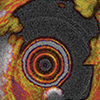

Emphasis
The emphasis is on development of cost effective, portable, safe, and non-invasive or minimally invasive devices, systems, and technologies for early detection, diagnosis, and treatment for a range of diseases and health conditions.
Program priorities and areas of interest
The supported research and development areas include:
- fluorescence imaging
- bioluminescence imaging
- optical coherence tomography (OCT)
- second harmonic generation (SHG)
- infrared (IR) imaging
- diffuse optical tomography
- optical microscopy and spectroscopy
- confocal microscopy
- multiphoton microscopy
- raman imaging
Additional support
This program also supports:
- early-stage validation of tools and devices
- development of innovative light sources and fiber optic imaging devices
- multimodal imaging
Related News
NIBIB-supported researchers have developed a smart nanoprobe designed to infiltrate prostate tumors and send back a signal using an optical imaging technique known as Raman spectroscopy. The new probe, evaluated in mice, has the potential to determine tumor aggressiveness and could also enable sequential monitoring of tumors during therapy to quickly determine if a treatment strategy is working.

Using state-of-the-art imaging technology, NIH-funded researchers have found the secret behind the glassfrog’s ability to become transparent, an effective form of camouflage. Future research may provide insights into disorders related to blood clotting or stroke in humans.

NIH today announced the winners of its NIH Technology Accelerator Challenge (NTAC) for Maternal Health, a prize competition for developers of diagnostic technologies to help improve maternal health around the world.

Doctors need better ways to detect and monitor heart disease, the leading cause of death in industrialized countries. Researchers with support from NIBIB has developed an improved optical imaging technique that found differences between potentially life-threatening coronary plaques and those posing less imminent danger for patients with coronary artery disease.
Researchers demonstrate critical improvements to functional Near Infrared Spectroscopy (fNIRS)-based optical imaging in the brain.

